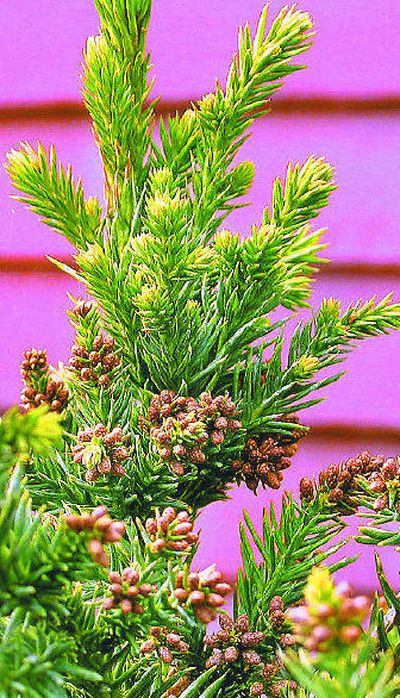Hardy dwarf stands tall

Years ago I bought a collection of dwarf conifers to add visual texture and year-around color to the landscape at my house.
Included in the group was something that is seldom seen in Spokane, but is proving to be a fine addition to the garden as it begins to gain some size.
Cryptomeria japonica ‘Black Dragon’ - also known as Japanese cedar - has been growing well for at least four years, and has survived a number of arctic blasts and early autumn freezes.
Cryptomeria has long been considered too sensitive to winter cold to survive in the Inland Northwest, but ‘Black Dragon’ is different. It stands alone for its cold hardiness among other Cryptomeria. One reference lists it as hardy down to zone 3. Others list it as hardy to zone 5. It appears the cultivar will survive to lows of minus 20 degrees Farenheit or colder, making it a match for our climate.
A plant expert at a local college said my purchase of ‘Black Dragon’ should be considered an experiment, and suggested that I not recommend it to readers. After four years of success, I can now say you will enjoy this shrub-like tree if you can find one. I got mine by mail order, although they are available at local nurseries including Judy’s Enchanted Garden, 2628 W. Northwest Boulevard, in Spokane and at Northland Nursery, 8093 W. Prairie Ave., north of Post Falls.
In the wild, Japanese cedar is known to grow to 50 or 60 feet in height, and one university Web site calls it “easy to grow.” With time, it develops a pyramidal, semi-formal look.
The ‘Black Dragon’ cultivar is unlikely to get taller than your head. Online nurseries list its mature height at seven to 12 feet, but in the Inland Northwest, any individual specimen will probably be smaller because of the shorter growing season here.
Mine has grown only a few inches each year, partly because I planted it against an east facing wall which keeps it out of the hot afternoon sun, and provides protection against its worst enemy – cold wind. Web references, however, indicate that it can handle heat.
Iseli Nursery, a wholesale mail-order business in western Oregon, lists more than a dozen cultivars of Cryptomeria, but only the ‘Black Dragon’ is hardy to minus 20. Most of the others are hardy to minus 10, which means they are likely to be damaged or killed by winter cold here at some point.
Iseli describes ‘Black Dragon’ as being “for the gardener who loves unique plants. ‘Black Dragon’ forms a wide pyramid, adorned year-round with dark green congested foliage.”
It goes on to call it the ideal accent plant for a small garden, but cautions that it needs protection from cold wind.
Its darkening foliage makes it a good accent against brighter colors.
‘Black Dragon’ is likely to be found in specialty nurseries only. Starter plants go for $13. More substantial specimens available locally are $30 and up.
Bizon Nursery, another Oregon wholesaler on the Web ( www.bizonnursery.com), said the plant is deer resistant and cold hardy to zone 3, which would make it suitable for all locations in the Inland Northwest. Bizon is in Wilsonville, Ore., just south of Portland.
The nursery recommends placing ‘Black Dragon’ with plants that have golden hues to match the yellowish new growth that emerges each spring. The softer color matures into a deep blackish green, thus the name ‘Black Dragon.’
Because of demand for it since its introduction some years ago, Bizon said ‘Black Dragon’ has proven to be one of the best of dwarf cultivars available.
I agree.